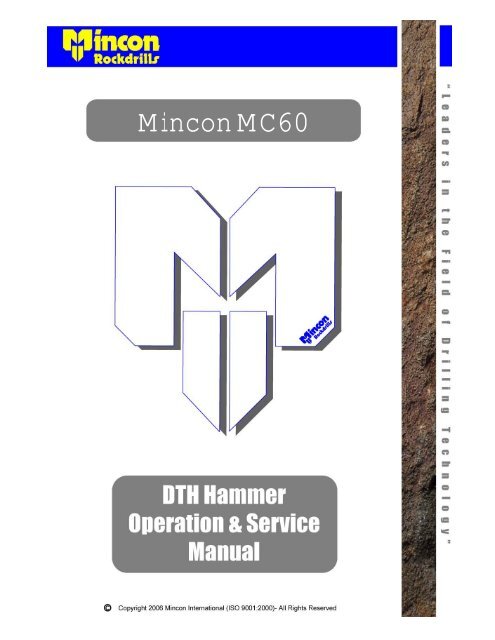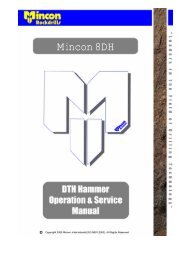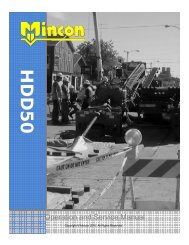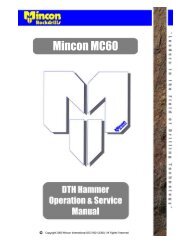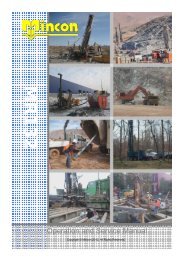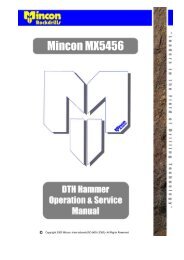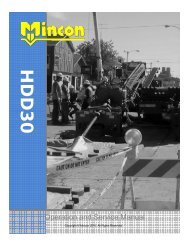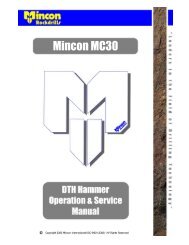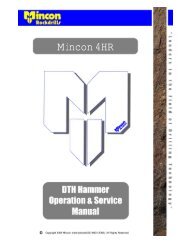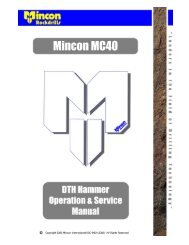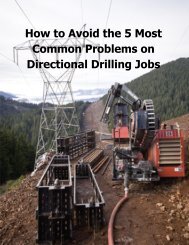MC60 Service Manual - Manufacturer of Top Quality Rockdrills ...
MC60 Service Manual - Manufacturer of Top Quality Rockdrills ...
MC60 Service Manual - Manufacturer of Top Quality Rockdrills ...
- No tags were found...
Create successful ePaper yourself
Turn your PDF publications into a flip-book with our unique Google optimized e-Paper software.
Mincon <strong>MC60</strong>
2.3.2 Opening Chuck and BackheadThe threads used in Mincon Hammers are right hand threads. Proper tools and break-out systems should be used at all times todismantle DTH hammers, otherwise damage may be caused to the components which could result in eventual failure or affect theperformance <strong>of</strong> the Hammer. When using Petol wrenches or similar systems, ensure that the wrench is not placed on the threadedsection <strong>of</strong> the wear sleeve. Petol wrench jaws should be carbide, and in good condition. It is good practice to keep a spare set <strong>of</strong>jaws with the rig. Do not strike or hit the outer components as this could weaken the heat treated steels. Hitting the hammer mayalso cause hard metal fragments to be chipped <strong>of</strong>f which may be projected and cause personal injury or eyesight loss.Do not apply heat to the hammer, as this can alter the metallurgical composition and result in premature failure. Additionally,applying heat can also cause distortion to the wear sleeve, which in turn would lead to failure. Do not trap the hammer under drillrig tracks or vehicle wheels which could cause bending and distortion <strong>of</strong> the hammer body. Failures caused by these actionscannot be supported by warranty.Take care when dismantling the hammer to make sure that parts and drill bits do not become detached and cause damage orpersonal injury.2.3.3 Dismantling Hammer to Change Drill BitWhen possible, dismantling the Hammer to change the drill bit is preferably best done in a workshop environment to avoid the risk<strong>of</strong> injury and for cleanliness. Be careful to ensure that the drill bit and chuck are fully supported together so that there is no risk <strong>of</strong>them becoming detached and causing injury. Before fitting a new drill bit visually inspect the splines <strong>of</strong> the chuck and the pistonstriking face to ensure that both are not damaged in any way.Place chuck onto the bit, and secure with the bit retaining ring into the top <strong>of</strong> the chuck. Liberally grease the threads on the chuck.Screw chuck into wear sleeve by hand, alternatively, if using the rig to screw chuck on, ensure that no cross threading occurs. Priorto use, place bit in a bit basket and torque up chuck. This is essential, as the chuck can loosen if not properly torqued, andpremature chuck failure can occur.2.3.4 Disassembly for Full Servicing <strong>of</strong> HammerBreakout the Chuck and Backhead as described previously. Unscrew chuck and remove bit and bit retaining ring. Unscrew thebackhead and check to see if the check valve and spring are operating correctly, and then remove them. Mark one end to identifyeither the chuck or backhead end for reassembly latter.Stand hammer up with the chuck end uppermost. Using a mild steel bar, tap the strike face <strong>of</strong> the piston to remove the airdistributor and inner cylinder. The steel make-up ring and lock ring should fall out during this process, if so remove them andcontinue until the top <strong>of</strong> the air distributor is at the top <strong>of</strong> the wear sleeve. The hammer can now be placed flat on the ground or putup onto a suitable vice, and using the mild steel bar, hit the piston strike face from the chuck end, to completely remove the airdistributor, inner cylinder and piston.Stand the wear sleeve up with the chuck end on the ground. Invert the piston and drop into the wear sleeve so that it is upsidedown. Take care to ensure that fingers do not get caught between the piston and wear sleeve. Again stand the hammer up withthe backhead end uppermost, and tap the piston strike face with the mild steel bar to remove the aligner. A number <strong>of</strong> blows maybe necessary as the aligner and wear sleeve are an interference fit.The piston retaining ring can be removed by using a mild steel bar and hitting the section opposite the gap on the ring which will rideup the taper on the wear sleeve and come out. It can then be pulled out by hand.2.3.5 InspectionPrior to inspection, thoroughly clean all parts using a suitable cleaning agent. Diesel is not recommended for cleaning as it cancause erosion to components, and damage to health.All parts should be visually inspected for any signs <strong>of</strong> damage, wear or cracking. The inner cylinder, wear sleeve and lock rings canbe checked for unseen cracking by suspending them and lightly tapping with a screw driver. If they emit a ringing tone then theyshould be sound. However, a dull flat tone if emitted may indicate cracking, and the part should be replaced.Take particular care to check the internal bore <strong>of</strong> the wearsleeve for pick-up marks and galling. If these are present, the barrel <strong>of</strong>the wear sleeve should be honed out, using a hand hone to remove them.Inspect surface <strong>of</strong> the piston for pick-up marks and galling (usually caused through poor lubrication or the presence <strong>of</strong>contaminants) and smooth out with emery paper or a hand held grit stone. Where galling <strong>of</strong> the piston has occurred, substantialheat has been generated and quite <strong>of</strong>ten, micro cracking has occurred on the piston. In these cases, the piston should be replacedif there is evidence <strong>of</strong> such cracking. Check the strike face <strong>of</strong> the piston for cracking or damage.Mincon <strong>Rockdrills</strong> – “The Driller’s Choice” Page 5
2.3.6 Checking Wear LimitsThe performance <strong>of</strong> the hammer is dependent on the amount <strong>of</strong> wear the critical components have. These should be measuredand recorded in the <strong>Service</strong> log in the appendix. The service log gives the location <strong>of</strong> where measurements should be made.Depending on how many parts need to be replaced, it may be economical to replace the hammer all together.Where the reverse wear limit has been reached on the outer diameter at the chuck end <strong>of</strong> the wear sleeve, the hammer can bereassembled with the backhead end becoming the chuck end. Additionally if the internal running surface in the wear sleeve for thepiston is excessive, the wear sleeve can be reversed.2.3.7 ReassemblyThe hammer can be reassembled in the following manner, referring to the exploded view <strong>of</strong> the hammer in the appendix. Ensure allcomponents are liberally coated with good quality rock drill oil and threads with thread grease.After identifying which end will be the chuck end, fit the piston retaining ring in this end. This can be pushed into place, using asmall bar or screwdriver to ensure that it is seated correctly. Stand the wear sleeve up with the chuck end to the top, and push thealigner in as far as it will go by hand. Using a steel dolly that fits into the wear sleeve and over the aligner, hit the aligner into placewith a sledgehammer. Place the bit retaining rings into the chuck and screw the chuck in place. If the chuck does not close up fully,the aligner is not in fully.Turn wear sleeve over with the chuck on the floor, and drop the piston in with the strike face in first. Again ensure that fingers donot get caught between the wear sleeve and the piston. Place the three piece seating ring on the inner cylinder and secure in placewith the seating ring O Ring. Insert The Air distributor into the inner cylinder at the seating ring end and using a s<strong>of</strong>t headed mallet,tap it into place so that it seats up against the top <strong>of</strong> the inner cylinder.Place the inner cylinder assembly into the wear sleeve, and tap down with a s<strong>of</strong>t headed mallet. When beginning to hit theassembly, ensure that it goes in square. Using a steel dolly, on top <strong>of</strong> the air distributor and inside the wear sleeve, drive theassembly into place with a sledgehammer.Drop the lock ring into place and then the steel make up ring on top <strong>of</strong> this. Insert the spring and check valve in place and finallyscrew the backhead in place. With the backhead in place, there should be a small gap between the backhead and the wearsleeve.This gap should be between 0.015” and 0.030”, and can be measured using a feeler gauge. If the gap is less than the minimum,then the lock ring will need to be replaced. Protect the hammer as earlier described by internal lubrication.Mincon <strong>Rockdrills</strong> – “The Driller’s Choice” Page 6
3. Trouble ShootingProblem Possible cause RemedyLow penetrationand high pressureRough or erraticoperationLow penetration /Low pressureDrill running <strong>of</strong>fbottomChuck shoulder length worn toomuchContamination in hammerToo much water injectionToo much feed pressureShoulder length <strong>of</strong> the chuck hasworn too muchRotation speed too slowWorn bit bearing (some modelsonly)Too much water injectionWorn drill clearancesLack <strong>of</strong> oilWorn pistonToo much water injectionChuck I/D is wornBearing I/D is worn.Measure chuck shoulder length against discard length and discard ifnecessary as air is restricted on the upstroke <strong>of</strong> the pistonOpen hammer and clean the obstructionReduce level <strong>of</strong> water in flowSet the feed pressure until the rotation starts to bind. Then back <strong>of</strong>f thefeed pressure until the rotation runs smoothlyMeasure the chuck shoulder against the discard length and discard ifnecessary as air is restricted to the upstroke <strong>of</strong> the drillDrill bit peripheral rotation speed <strong>of</strong> 12 – 15” per second (300-380mm).Place chalk mark on drill rod and check the advance revolution. Ifgreater than ½” (12mm) per revolution increase rotation until theadvance per revolution is a maximum <strong>of</strong> between 3/8” – ½” (10-12mm)Replace bit bearing if outside discard limitReduce level <strong>of</strong> water injectionInspect piston, inner cylinder, wearsleeve, air distributor probe andbearing against discard measurements as outlined in repair section 2.2and discard as necessaryEnsure there is an oil film coming from bit spline and bit parts. (Placecardboard under bit to check)Measure the large end <strong>of</strong> the piston for wear. If air leaks past this areait can cause the piston to cycle when <strong>of</strong>f bottomReduce water injection flowReplace chuck.Replace bearing.PART FAILUREProblem Possible cause RemedyCrackedwearsleeveCracked backheadbodyPiston crackedthrough largediameterPiston strike endbreakingAbuse <strong>of</strong> wearsleeveWorn wearsleeveCorrosionBogged Drill requiring lots <strong>of</strong> fightingto recover the drillLack <strong>of</strong> lubrication causes microcracksleading to breakageDrill badly bogged which can causewearsleeve to distort (causingfunctional heat and cracks)Feeding hard through voids onbroken ground can causewearsleeve to distort causing heatand cracksUsing wrench over wrong areacauses wearsleeve to distortNot enough down-forceContamination from excess waterinjection causes pitting in the pistonface and external failureAvoid welding, heating or torque wrenching in the wrong place asoutlined in section 1.4. Note also section 1.6Casing has worn beyond the discard point. Measure casing O/Dapprox. 3” from chuck end and backhead end and replace if necessaryEnsure a pH neutral water, well filtered and free from contaminants isused in the drill. Corrosion usually accelerates from the threaded areaor any undercut area. Coat with corrosion protector if there is anydanger <strong>of</strong> corrosionIf such danger is imminent use a dig out subCheck lubricator and ensure oil film on the bit splines and slow holesFlood tool with water when boggedUse light feed and ensure the hole is kept clean and consolidated.Use foam or mud if necessaryUse wrench only in theArea indicated in spec 1.4Increase feed until rotation binds and pressure pulses and then back<strong>of</strong>f until the rotation and pressure becomes smoothAvoid excessive water. Use only pH neutral water. Use only filteredwater, free from contaminationMincon <strong>Rockdrills</strong> – “The Driller’s Choice” Page 7
4. Appendix4.1 DTH Hammer exploded view and Parts List and Technical DataMINCON <strong>MC60</strong> PARTS LIST AND SPECIFICATIONS12345678910111213141516171819Item Description Part NumberMincon <strong>MC60</strong> HammerMD601AS081 Backhead MD601BH012 O Ring MD623OR013 Choke Blank MB506CH01Choke 1/8” (3.2mm)MB506CH02Choke 3/16” (4.8mm)MB506CH034 Check Valve MB502CV015 Spring MB503SP016 Steel Make-up Ring MD604SM017 Lock Ring MD605LR018 Air Distributor MD607DR019 O Ring MD621OR0110 O Ring MD620OR0111 Seating Ring MD609SR0112 Inner Cylinder MD608IC0113 Piston MD610PN0514 Wear Sleeve MD611WS0115 Piston Retaining Ring MD612PR0116 Aligner MB613BB0417 O Ring MD622OR0118 Bit Retaining Ring MD614BR0519 Chuck MD615CK04Outside diameter 5.5” 140mmMinimum Bit Size 6” 152mmSpanner Flat Size 4” 100mmLength (Less Bit, Backhead Shoulder to Chuck)Bit Shank TypeMC61Backhead Thread3 ½” A.P.I. Reg. PinPiston Weight 46 Lbs 21 KgsWear Sleeve Reverse Limit 5.310” 135.0mmWear Sleeve Discard Limit 5.060” 128.5mmMincon <strong>Rockdrills</strong> – “The Driller’s Choice” Page 8
4.2 Hammer <strong>Service</strong> LogWEARSLEEVE / PISTON CLEARANCEPart New Dimension As Measured Wear Actual Clearance Discard ClearanceWearsleeve A 4.560” (115.83mm) C C-APiston OD B 4.555” (115.70mm) D B-DC-D≥ 0.010” (0.25mm)Chuck endCDINNER CYLINDER / PISTON CLEARANCEPart New Dimension As Measured Wear Actual Clearance Discard ClearanceCylinder ID A 4.068” (103.33mm) C C-AC-D≥ 0.010” (0.25mm)Piston OD B 4.063” (103.20mm) D B-DDCDISTRIBUTOR PROBE / PISTON ID CLEARANCEPart New Dimension As Measured Wear Actual Clearance Discard ClearanceDistributor Probe OD A 1.326” (33.70mm) C C-AC-D≥ 0.010” (0.25mm)Piston ID B 1.334” (33.90mm) D B-DCDDISTRIBUTOR PROBE / PISTON ID CLEARANCEPart New Dimension As Measured Wear Actual Clearance Discard ClearanceAligner ID A 3.278” (83.25mm) C C-AC-D≥ 0.016” (0.4mm)Piston Nose OD B 3.268” (83.00mm) D B-DDCEXTERNAL WEARDescription Wear Limit As MeasuredWearsleeve Reverse Dimension:5.310”( 135.00mm)Wearsleeve Discard Dimension:5.060” (128.50mm)Note 1: If no evidence <strong>of</strong> significant air pressure drop or if wearsleeve is wearing evenly on the top and bottom end, recommendation is to notreverse wearsleeve.Note 2: Chuck should be replaced when wear transfers to wearsleeve.Mincon <strong>Rockdrills</strong> – “The Driller’s Choice” Page 9
5. WarrantyMincon DTH HAMMERSWarranty, October 2002Mincon warrants that the Mincon DTH Hammers and spare parts therefore, manufactured by Mincon and delivered to the initial userto be free <strong>of</strong> defects in materials or workmanship for a period <strong>of</strong> 3 months after initial operation or 6 months from the date <strong>of</strong>shipment to the initial user, whichever occurs first. Mincon may elect to repair the defective part or issue full or partial credit towardsthe purchase <strong>of</strong> a new part. The extent <strong>of</strong> credit issued will be determined on a pro-rata basis bearing in mind the service life <strong>of</strong> thedefective part against the normal service life <strong>of</strong> that part. The part will be replaced or repaired without charge to the initial user at theplace <strong>of</strong> business <strong>of</strong> an authorized Mincon distributor during normal working hours. The user must present pro<strong>of</strong> <strong>of</strong> purchase at thetime <strong>of</strong> exercising the warranty.The warranty applies only to failures resulting from defects in the material or workmanship and does not apply to failures occurringas a result <strong>of</strong> abuse, misuse, corrosion, erosion, negligent repairs and normal wear and tear. Failure to follow recommendedoperating and maintenance procedures which result in component failure will not be considered for warranty.This warranty is in lieu <strong>of</strong> all other warranties, other than title, expressed or implied.Limitation <strong>of</strong> LiabilityMincon will not accept any remedies to the user other than those set out under the provisions <strong>of</strong> warranty above. The total liability <strong>of</strong>Mincon or its distributors with respect to the sale <strong>of</strong> DTH Hammers or spare parts therefor, whether based on contract, negligence,warranty, indemnity or otherwise shall not exceed the purchase price <strong>of</strong> the product upon which such liability is based. Mincon andits distributors shall in no event be liable to any party relating to this sale for any consequential, indirect, special or punitive damagesarising out <strong>of</strong> this sale or any breach there<strong>of</strong>, or any defects in or failure <strong>of</strong> or malfunction <strong>of</strong> the Mincon DTH Hammer or spareparts.Warranty will be voided where:• There is evidence <strong>of</strong> damage resulting from insufficient or incorrect lubrication.• There is evidence <strong>of</strong> misuse through the application <strong>of</strong> heat, welding or <strong>of</strong> being struck.• There is evidence <strong>of</strong> distortion or bending however caused.• There is damage caused as a result <strong>of</strong> using incorrect servicing tools or procedures.• If it is evident that the hammer or its components have achieved a reasonable proportion <strong>of</strong> their anticipated life.Mincon <strong>Rockdrills</strong> – “The Driller’s Choice” Page 10


